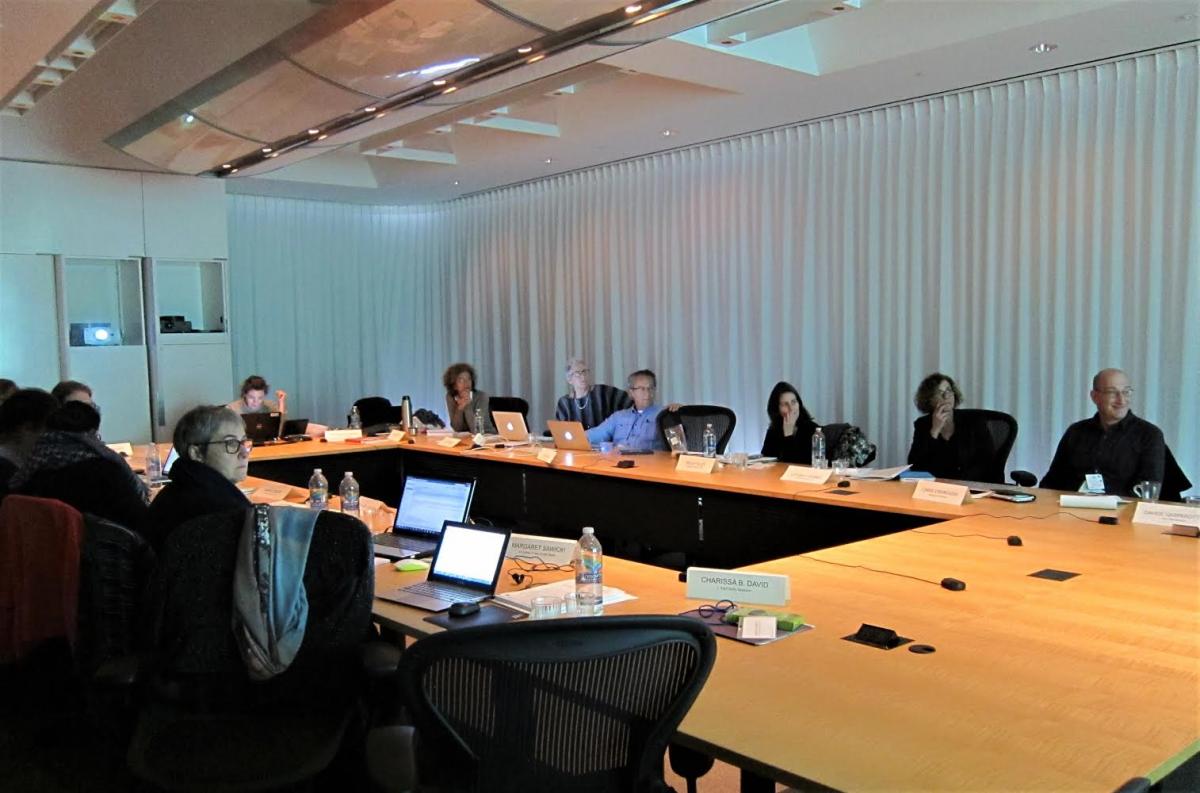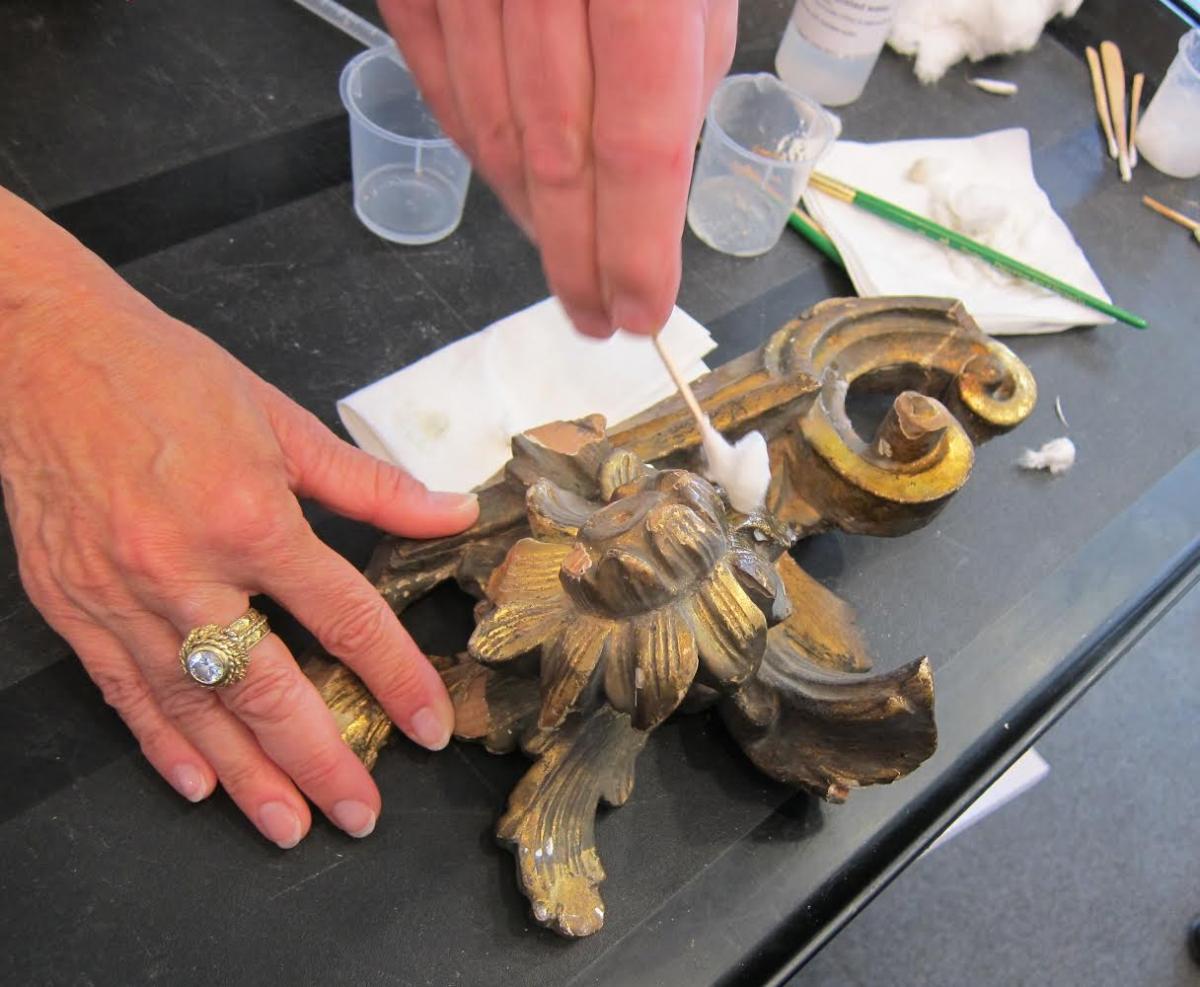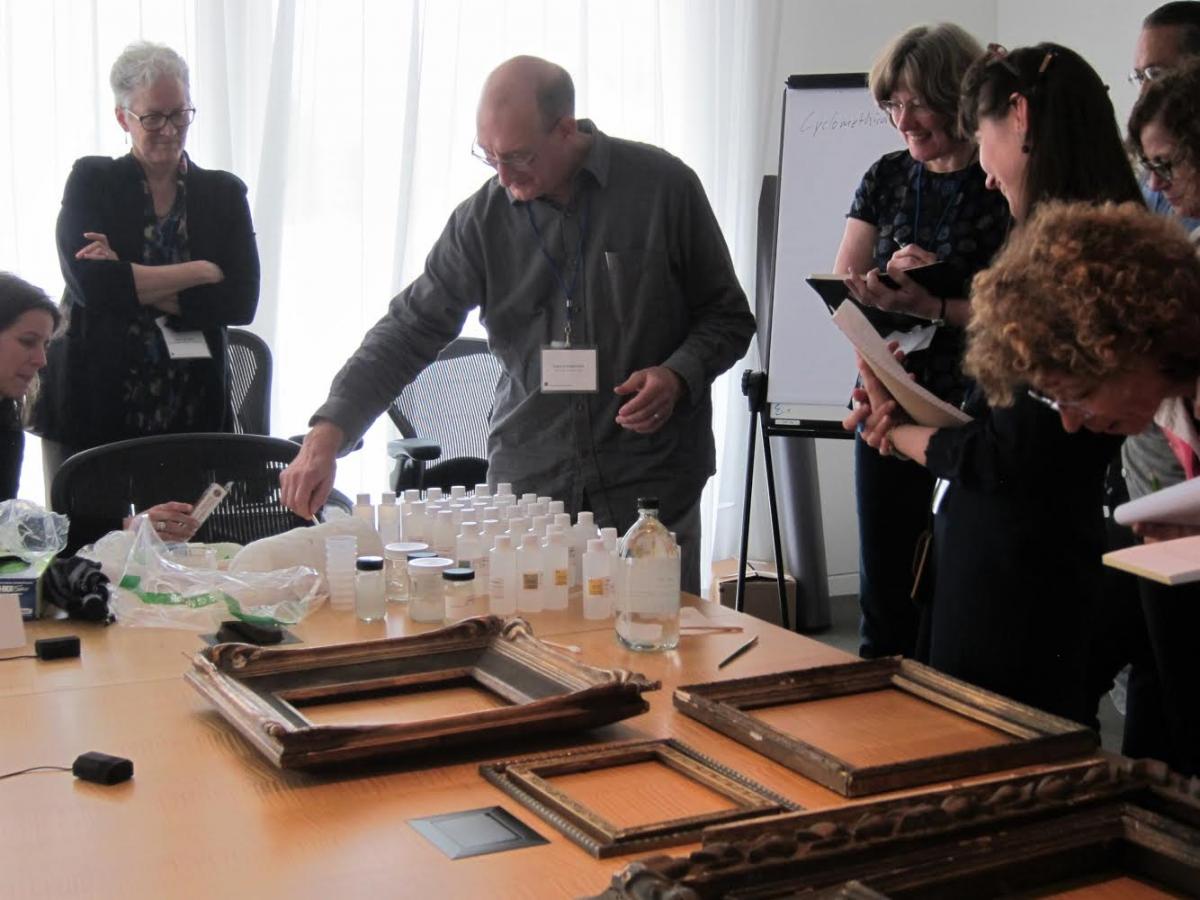In March 12-14, 2018, I attended the Experts Meeting on the Cleaning of Wooden Gilded Surfaces hosted by The Getty Conservation Institute (GCI), Los Angeles, CA, US. The meeting was by invitation only, so I was honoured to find myself in the group of twelve people from all over the world marked as ‘experts’ in gilded objects conservation. The meeting was organised and moderated by Dr Stephanie Auffret, GCI Project Specialist and Coordinator of the ICOM-CC Wood, Furniture and Lacquer Working Group. The aim of the meeting was to discuss the scope of issues regarding conservation of wooden gilded objects, with a particular focus on surface cleaning. Over three days the twelve participants, along with GCI staff, addressed the state of knowledge of wooden gilded surfaces in various parts of the world. We discussed the ethical considerations related to their preservation, training opportunities and needs and methods to study and document gilded surfaces. We further discussed the cleaning systems available for treatment of the heritage gilding as well as the effects of these cleaning systems on gilded surfaces.

The first day concentrated on acquainting ourselves with each other. We learnt about one another’s backgrounds and our goals and approaches to gilding and gilding conservation methodology. Dr Davide Gasparotto, Senior Curator, Department of Paintings at The J. Paul Getty Museum, who is an acknowledged specialist of Renaissance art and has a special interest in frames and decorative art joined us. Gene Karraker, Associate Conservator of Frames at The J. Paul Getty Museum, Silvia Ottolini, Painting Conservator and a volunteer at The J. Paul Getty Museum were also in attendance.
Each participant presented a 20-minute PowerPoint presentation based on the several questions distributed to all of us in preparation for the meeting in late 2017. The topics were as follows:
-
What is the level of knowledge of wooden gilded surfaces in your country?
-
Who makes decisions when it comes to treatment of gilded surfaces and how efficient is the dialogue between conservators and decision makers?
-
What cleaning systems are used in your country?
-
What are the education offerings and needs in regards to cleaning systems applied to wooden gilded surfaces in your country?
Working for over 40 years in the gilding conservation field, and for over 30 of these years in Australia, I do have sound knowledge and indeed, strong opinion, on all these issues. However, I wanted to present a fair voice from Australia rather than my own judgmental interpretation. So I contacted my colleagues in other state institutions to obtain objective overview on these subjects. At the end, the goal was to learn about diverse perspectives on the field of conservation of wooden gilded surfaces in varied parts of the world. It formed a base for discussions over the 3 days of the meeting.

The morning sessions of the next day were devoted to evaluation of the field of wooden gilded surfaces preservation from the perspective of the various stakeholders involved in the treatments decision-making process. For this session our group was extended by Charissa B. David, Associate Curator of Sculpture and Decorative Arts at the J. Paul Getty Museum. We deliberated on the profile of conservators of wooden gilded surfaces: their training, level of specialization, work environment, professional ethics. We discussed what the training opportunities are for conservators in various countries, from initial training to professional development, and to my surprise I learnt that struggling for the identity and professional recognition is relevant to gilded objects conservators in all parts of the world, including countries so rich in gilding heritage as France and Italy.
We talked about the various stakeholders involved in conservation campaigns, their influence on treatments of gilded objects and differences in the ethical considerations. It appeared to me that Australia in its marginalised interest in gilding conservation is at least a winner when it comes to the quality of the dialogue between various stakeholders, particularly between curators and conservators. This dialogue in Australian institutions is usually effectual and practical, and the decision-making process in regards to gilding conservation bases often on thorough discussion and collaboration, in which the advice and input of the gilded objects/ frames conservation staff is recognised and taken seriously.
Nevertheless the debate around the question how to reach out to the various stakeholders in order to raise awareness of the importance to preserve historical gilded surfaces was intense and took a great part of the morning session. It was finished with paying a brief visit to the J. Paul Getty Museum with Charissa B. David and Dr Davide Gasparotto as our exclusive guides.
Later in the day I gave a short presentation on using laser systems in cleaning of wooden gilded surfaces. The afternoon was devoted to the discussion led by Chris Stavroudis, Paintings Conservator and Conservation Scientist. This discussion focused on cleaning options for gilded wood. Chris’ opinion, knowledge and expertise in regard to cleaning of sensitive surfaces will be invaluable in this new project, although he very openly stated that since the disastrous experience he had with cleaning the gilded surface very early in his career, he does not touch gilded wood, leaving it to the specialists in this field.
There was a selection of gilded objects, mainly frames, for testing varied cleaning systems based on gels and emulsions. It occurred immediately to everybody that without thorough examination of these gilded surfaces any testing will be impossible. This is the nature of gilding; very rarely conservators deal just with wooden gilded surface. Most often gilded wood is coated with various varnishes, original or secondary, or overpainting (particularly brass-based overpainting) or regilding or all of them, in addition to soot, grim and dirt.

The first attempt to initiate establishing the protocol for cleaning of wooden gilded surfaces was not really successful. However, we learnt from this experience that we all need to get involved in a thorough methodical assessments of available materials and methods before we get to the establishing of the methodology for cleaning.
That evening, we were all invited to the elegant dinner at the conveniently located Luxe Sunset Boulevard Hotel, where we all were staying. We were joined at the dinner by Jeanne Marie Teutonico, GCI Associate Director of Programs, and Kathleen Dardes, Head of GCI’s Collections Department. It was great to learn that the new GCI project on Cleaning Systems for Wooden Gilded Surfaces has huge support and recognition from GCI’s executives.
The morning session of the last day was dedicated to discussion on analytical tools available to evaluate gilded surfaces and the effects of cleaning systems basing on our diverse experiences. Presentations and discussions were led by Nathalie Balcar, Conservation Scientist Centre de Recherche et de Restauration des Musées de France, France, and Dr Luiz Souza, Head, Conservation Science Laboratory School of Fine Arts Federal University of Minas Gerais, Brazil. Nathalie stressed importance of the examination of cross sections of gilded surfaces in order to understand their stratigraphy, original gilding techniques as well as materials involved. For analysing of cross-sections she uses fluorescence microscopy, SEM-EDX, fluorochrome staining techniques, and FTIR. She stressed usefulness of the initial examination of the gilded surface with a portable UV light as well as taking cross-sections of the surface after cleaning for potential identification of the residue of cleaning systems.
Two colleagues from the GCI Science Department joined this session; Dr Michael Schilling, Senior Scientist, Head of Materials Characterization Research, and Douglas MacLennan, Research Laboratory Associate. With several GCI projects running concurrently, the new project on Cleaning Systems for Wooden Gilded Surfaces intends to draw upon the GCI’s extensive experience with cleaning systems for acrylic paintings (Cleaning of Acrylic Painted Surfaces), which can serve as a foundation for cleaning other types of water/polar solvents sensitive surfaces, such as gilded surfaces. This new project can also benefit from research on the GCI project on Characterization of Asian and European Lacquers, which after running for several years, now came to the treatment researching phase, particularly in regard to surface cleaning of lacquer. Therefore, involvement of both Chris Stavroudisand Michael Schilling in the Cleaning Systems for Wooden Gilded Surfaces project is very welcome.
Before lunch, we were able to squeeze the visit to the Frames Conservation and the Paintings Conservation Laboratories at the J. Paul Getty Museum, admiring their space and setup.

The afternoon session focused on discussion of options for addressing training and information needs over the course of the next two years, and to define specific priorities that could be addressed through workshops, meetings or didactic resources. The list of topics we intended to discuss included
-
Documentation/ assessment of a wooden gilded surface.
-
Analytical methods available to document a wooden surface and to evaluate the effects of cleaning (from low tech to high tech). Documentation protocol using analytical tools.
-
Terminology to document a wooden gilded surface.
-
Gilding techniques and materials used in different countries (originally and during restoration campaigns).
-
Evaluation of varied surface cleaning methods, particularly methods based on gels and emulsions
-
Cleaning tests protocol and recording methods
-
Bibliography
Two websites were flagged as the interesting helping tools in documenting of wooden gilded surfaces: Interdisciplinary Multilingual Dictionary: http://www.imd.pk.edu.pl/, and GILT-Teller: interdisciplinary multi-scale study of the gilding materials and techniques in Portugal, 1500 – 1800: https://sites.fct.unl.pt/gilt-teller/
The conference was amazing, however, there was simply not enough time to even scratch the surface of these topics, each could form a theme for a separate debate. We all realised that the entire project is huge. It requires a prioritisation, sensible plan, and methodical strategy; in other words a lot of work and good collaboration. But this is just the beginning.
So stay tuned if you have gilded objects conservation at your heart!
List of participants of the Experts Meeting on the Cleaning of Wooden Gilded Surfaces, The Getty Conservation Institute), Los Angeles, CA, March 12-14, 2018:
Organiser and moderator: Dr Stephanie Auffret, GCI Project Specialist, Los Angeles, US
Zoe Allen, Head of Furniture Conservation, Victoria and Albert Museum, London, UK
Nathalie Balcar, Conservation Scientist, Centre de Recherche et de Restauration des, Musées de France, Paris, France
Sydney Beall, Postgraduate Associate (Fellow) in Paintings Conservation, Yale University Art Gallery, New Haven, US
Stéphanie Courtier, Conservator of Gilded Wood, Centre de Recherche et de Restauration des Musées de France, Paris, France
Marie Dubost, Conservator of Gilded and Painted Wood, Atelier de la Feuille d’Or, Paris, France
Mary McGinn, Paintings Conservator, Pennsylvania Academy of the Fine Arts, Philadelphia, US
Peggy Olley, Associate Conservator of Furniture and Woodwork, Philadelphia Museum of Art, US
Dr Leticia Ordoñez Goded, Furniture Conservator, Arcaz Restauración S.L., Madrid, Spain
Silvia Ottolini, Painting Conservator and a volunteer at The J. Paul Getty Museum, Los Angeles, US
Dr Malgorzata Sawicki, Head, Frames Conservation, Art Gallery of New South Wales, Sydney, Australia
Dr Luiz Souza, Head, Conservation Science Laboratory, School of Fine Arts, Federal University of Minas Gerais, Brazil
Chris Stavroudis, Paintings Conservator, Los Angeles, US.
Judy Wetherall, Conservator, Gilding and Decorative Surfaces, Knole Conservation Studio, Knole House, Kent, UK